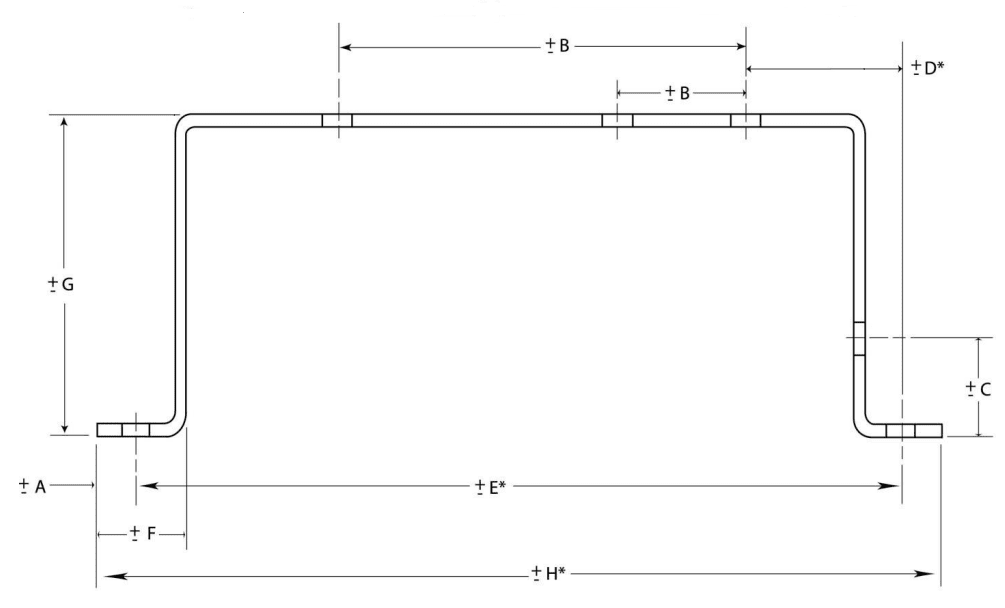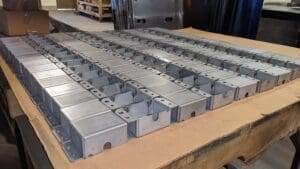Last updated on February 16th, 2024 at 09:24 am
One of the materials we love working with at Approved Sheet Metal is stainless steel. It’s everything you could want out of sheet metal—it’s durable, strong, and resistant to rust and wear. But what a lot of people don’t know is, aside from it being the superhero of steel, stainless doesn’t always have to mean a heftier price tag. In fact, here are a few things you may not know about stainless that can affect the bottom line:
- Stainless can save costs on finishing. If galvanized steel needs to be finished, zinc-plating will run you about $4,200 for 1-50 parts. If you’re making 50+ parts, the additional cost of stainless steel starts to balance with the savings of not zinc-plating. Plus, stainless won’t rust and decay as quickly as galvanized steel will.
 Thinner stainless won’t necessarily save you money. Some people will opt for .047 stainless steel to cut down on costs. But .047 stainless steel warps easily and is hard to keep straight, which can create delays or make for a more expensive quote. .074 is usually a better thickness for welding stainless steel parts.
Thinner stainless won’t necessarily save you money. Some people will opt for .047 stainless steel to cut down on costs. But .047 stainless steel warps easily and is hard to keep straight, which can create delays or make for a more expensive quote. .074 is usually a better thickness for welding stainless steel parts.- When strength matters, stainless is the way to go. We get a lot of requests for .25 galvanized steel when a part needs to be really sturdy. But you can usually swap out .25 for a thinner stainless because the material is harder and stronger.
Table of Contents
- 1 Stainless vs. Galvanized Steel
- 2 Recommended Default Sheet Metal Tolerances
- 3 Stainless Steel Fabrication FAQ
- 3.0.1 What are the cost-saving benefits of using stainless steel in sheet metal fabrication?
- 3.0.2 Is thinner stainless steel a cost-effective choice for sheet metal fabrication?
- 3.0.3 How does stainless steel compare to galvanized steel in terms of strength?
- 3.0.4 What are the main differences between stainless steel and galvanized steel?
- 3.0.5 Why do people still use galvanized steel despite stainless steel being superior in many aspects?
Stainless vs. Galvanized Steel
At our sheet metal shop, we get questions all the time about material selection. Engineers want to know which material is the best choice for their sheet metal fabrication: stainless or galvanized or zinc-coated steel?
Factors like resistance to corrosion, strength, and of course, cost-effectiveness all matter when choosing a material for your part.
Let’s see what our contenders have to offer.
Drumroll, please:
In one corner, we have zinc-coated steel, otherwise known as “galvanized steel.” Galvanized steel is hot-dipped in a pool of zinc, which gives it a thicker coating than regular electroplated zinc-coated steel. Zinc is an alloy that fights corrosion.
In the other corner, we have stainless steel. A solid mass of metal alloys, Stainless is composed of at least 10% chromium, nickel, iron, and carbon.
Each contender will be judged on resistance to corrosion, damage, and water; temperature; tolerance; chlorine resistance; and STRENGTH.
Let the games begin!
So, if stainless is better on almost all counts, why do people still use galvanized steel?
The only real advantage to using galvanized steel is price. Upfront costs will be lower for a part made of galvanized steel than stainless. But galvanized steel has some hidden costs, and if you need a part that’s going to last, stainless is the better bet.
Need some custom-fabricated stainless, sheet metal parts fast? Approved Sheet Metal can do sheet metal prototyping and low-volume orders delivered to you in 2-10 days! Request a quote today.





